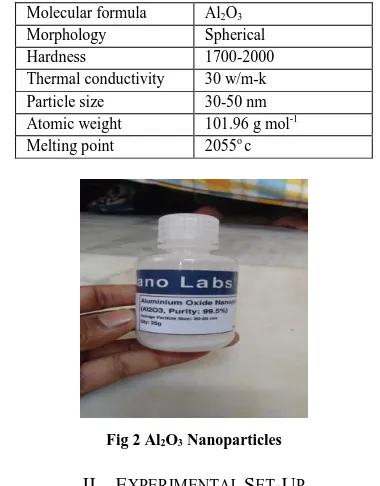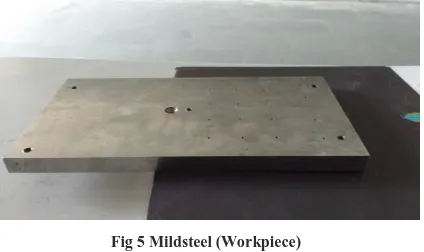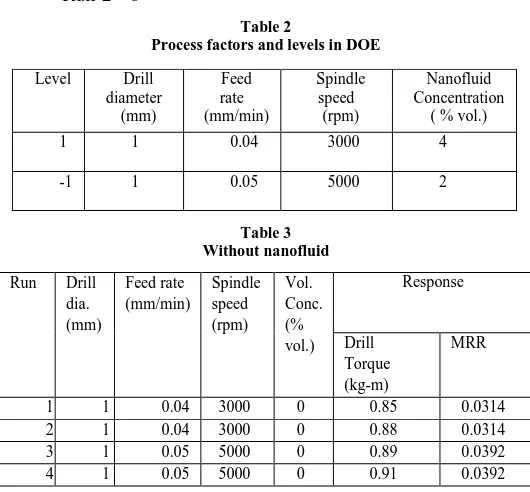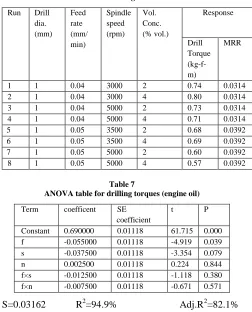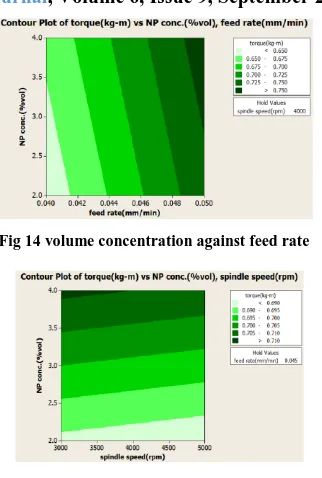International Journal of Emerging Technology and Advanced Engineering
Website: www.ijetae.com (ISSN 2250-2459, ISO 9001:2008 Certified Journal, Volume 6, Issue 9, September 2016)
27
Optimization of Drilling Parameters Using Nanofluid Minimum
Quantity Lubrication
Ivan Sunit Rout
1, Manabhanjan Sahoo
21
Assistant Professor, Department of Mechanical Engineering, Faculty of Engineering, Christ University, Bangalore, India 2
Assistant Professor, Department of Mechanical Engineering, C.V.Raman College of Engineering, Bhubaneswar, India
Abstract—MQL machining uses mixture of high pressure air and tiny amount of oil, which is supplied to the machining interface. For MQL machining, the fluid vapourises during the process leaving dry chips, thus it is cost effective and environmental friendly. Experimental results have been carried out in CNC vertical milling machine. In this paper, four controllable process factors i.e.drill diameter, feed rate, spindle speed and volumetric concentration of nano-diamond particles will be taken into considerations, and thus 16 experimental runs have been sorted for each base fluid to find drilling torque.
Keywords—Engine oil, Paraffin oil, Drilling torque, RSM, nanoparticles
I. INTRODUCTION
Environmental friendliness has become one of the biggest issues in modern industry worldwide, along with maintaining high precision and factory automation. In addition, recent regulations on environmental problems, such as ISO 14000 and Green Round, have become much stricter for promoting green manufacturing approaches. This increased the necessity of reducing environmental loads, and many environmentally friendly manufacturing processes have been developed and studied. Although
various ways have been considered to achieve
environmental friendliness, reducing the usage of metal working fluids (MWF) in machining processes has been a significant issue as an effective means to reduce environmental loads.
MWFs are commonly used to cool and lubricate the contact interfaces of a tool and workpiece. The application of a MWF improves the surface quality of the workpiece, prolongs tool life, and removes chips from the cutting zone. Despite this excellent performance, MWFs can have adverse effects on human health and the environment. Calvert et al. reported that exposure to MWF can increase the risk of cancer of the larynx, rectum, pancreas, skin, scrotum, and bladder. Another important issue to be resolved is the disposal cost of used MWF. According to Klocke and Eisenblatter and Braga et al., the cost of disposing of waste oil accounted for a high percentage of total manufacturing cost to reduce environmental loads.
Milling can be done with a wide range ofmachine tools. The original class of machine tools for milling was the milling machine (often called a mill). After the advent of computer numerical control (CNC), milling machines evolved into machining centers (milling machines with automatic tool changers, tool magazines or carousels, CNC control, coolant systems, and enclosures), generally classified as vertical machining centers (VMCs) and horizontal machining centers (HMCs). The integration of milling into turningenvironments and of turning into milling environments, begun with live tooling for lathes and the occasional use of mills for turning operations, led to a new class of machine tools, multitasking machines (MTMs), which are purpose-built to provide for a default machining strategy of using any combination of milling and turning within the same work envelope.
Fig 1 CNC Vertical Milling Machine
International Journal of Emerging Technology and Advanced Engineering
Website: www.ijetae.com (ISSN 2250-2459, ISO 9001:2008 Certified Journal, Volume 6, Issue 9, September 2016)
28
A. Characterisation and selection of nano particles
Numerous nano particles in oil additives as lubricants and coolants have been used in diverse applications such as automobiles and electric devices due to their superior characteristics in terms of lubrication, wear resistance and cooling. Therefore, those nano particles could also be applied to various machining processes with minimum quantity lubrication (MQL) approach for surface quality enhancement, tool life extension and environmental friendliness.
The structure, shape, and size of nano particles play an important role in their tribological properties. Choi et al. and Lee et al. studied the lubrication characteristics of nanofluids with nano particles having various shapes and sizes. They found smaller particle additives decrease the workpiece wear and the friction coefficient. Micro-scale particles can degrade the lubrication characteristics of pure oil because they are dispersed in an unstable condition. They also found that spheres have a better lubrication effect than fiber shapes because of their stable dispersion. Battez et al. investigated the anti-wear behavior of nano particle suspensions in a polyalphaolefin6 and found that the size and hardness of nano particles in an oil additive can be important to the tribological properties.
Jeng et al. reported toxicity profiles of numerous metal
oxide nano particles, including TiO2, ZnO, Fe3O4, Al2O3,
and CrO3, with particle sizes ranging from 30 to 45 nm.
They summarized that ZnO was highly toxic, whereas
Al2O3, Fe3O4 and TiO2 exhibited moderate or slight toxicity
at the high concentrations. CrO3 displayed no toxicity at the
tested concentrations.
Therefore, Al2O3 has been selected for nano particles in
this study due to its non-toxicity to humans and spherical shapes for enhanced tribological attributes. In machining applications, other properties of the selected nano particle such as hardness and thermal conductivity are also significant for affecting lubrication and wear behaviors. Table 1 shows the hardness and thermal conductivity of
Al2O3nano particles. It also has phase stability and good
[image:2.612.347.537.157.400.2]dimensional stability when dispersed in water. It can significantly improve density, smoothness, thermal fatigue resistance, fracture toughness, creep resistance and polymer products wear resistance. It provides good thermal insulation.
Table 1
Specification of Nanoparticles
Molecular formula Al2O3
Morphology Spherical
Hardness 1700-2000
Thermal conductivity 30 w/m-k
Particle size 30-50 nm
Atomic weight 101.96 g mol-1
Melting point 2055o c
Fig 2 Al2O3 Nanoparticles
II. EXPERIMENTAL SET-UP
A. Base Fluid
To increase heat transfer and tribological properties of nanofluid basefluid is used. Tribology research shows that lubricating oils or basefluids with nano particles additives exhibits improve load carrying capacity, anti-wear and friction reduction properties. In this experiment we will use paraffin oil, engine oil, as all these are eco-friendly, low cost and effective as a basefluids. Paraffin oil offers
properties such as good lubricity, smoothness and softness
and resistance to moisture in the formulations. Engine oil has high viscosity and density.It significantlyimproves the anti-wear properties, if it is used as base fluid.
[image:2.612.330.568.561.631.2]International Journal of Emerging Technology and Advanced Engineering
Website: www.ijetae.com (ISSN 2250-2459, ISO 9001:2008 Certified Journal, Volume 6, Issue 9, September 2016)
[image:3.612.347.549.192.365.2]29 Fig 4 Engine Oil
B. Tool And Workpiece
A common requirement for tools is that the workpiece should have a minimal adverse effect on the tool in order for the tool to do its work successfully and for it to have a reasonable lifetime. In this experiment, HSS twist drill has been taken because it can withstand high temperature without losing it's hardness. In this experiment, mild steel as workpiece has been used.
The ductility, hardness and tensile strength is a function of the amount of carbon and other hardening agents present in the alloy. Mild steel is a steel in which the main interstitial alloying constituent is carbon in the range of 0.12- 2.0%. Mild steel is also known as plaincarbon steel is now the most common form of steel because its price is relatively low while it provides material properties that are acceptable for many applications.
Fig 5 Mildsteel (Workpiece)
The accessories and cutting tools used on machine tools (including milling machines) are referred to in aggregate by the mass noun "tooling". There is a high degree of standardization of the tooling used with CNC milling machines, and a lesser degree with manual milling machines. To ease up the organization of the tooling in CNC production many companies use a tool management solution. HSS is a subset of tool steel, commonly used in tool bits and cutting tools. It is often used in power-saw blades and drill bits.
[image:3.612.63.275.456.582.2]It can with stand higher temperature without losing its hardness. This property allows HSS to cut faster than highcarbon steel hence the name high speed steel. At room temperature it shows high hardness and abrasion resistance.
Fig 6 HSS Twist Drill (Cutting tool)
C. Minimum quantity lubrication
Minimum Quantity Lubrication (MQL) refers to the use of a precision dispenser to supply a miniscule amount of cutting fluid to the tool-workpiece interface – typically at a flow rate of 50 to 500 ml/hour –which is about three to four orders of magnitude lower than the amount commonly used in a flood cooling condition (Autret et al. 2003).
D. Nanofluid synthesis
Al2O3 is not stable in paraffin oil; therefore, surfactants
are used for dispersion of the Al2O3 nanoparticles. The
surfactant is prepared by mixing surface active agents (TW80 and SP80) with the ratio of 1: 1 in volume, and then
the surfactant, DI water and Al2O3 are mixed in a ratio of
8:5:2, by volume. The volume fraction of the Al2O3 powder
is calculated from the weight of the dry powder using the true density provided by the supplier and the total volume of the suspension. The mixtures are then de-agglomerated by intensive ultrasonication for 3 hours after mixing with the base fluid – paraffin oil. Finally, the suspension is homogenized for 1 hour by magnetic force agitation.
Dispersion of the Al2O3 nanoparticles is monitored for 24
hours without any trace of visible particle sedimentation. In this study an optimal composition of 0.5 volume %
Al2O3nano-particle separately dispersed in SAE 15W40
International Journal of Emerging Technology and Advanced Engineering
Website: www.ijetae.com (ISSN 2250-2459, ISO 9001:2008 Certified Journal, Volume 6, Issue 9, September 2016)
30
The oil properties can be studied by measuring the viscosity index (VI), total acid number (TAN) and flash point temperature. The stability of nano-particles in oil can be observed by measuring the absorption value over time using ultraviolet spectrometer. The dispersion of nano-oil can be stable upto 168 hour before the sedimentation occurs (M.I. Hakami Chua Abdullah et al. 2014). Effect of
[image:4.612.46.293.229.402.2]HBN (Al2O3 nano particles on engine oil properties).
Fig 7 Nanofluid mixing using magnetic stirrer
E. Experimental Procedure
In this experiments a DOE (Design Of Experiment) approach is used to find critical variables having significant effects on the drilling performances. In the DOE approach, central composite design (CCD) was applied for the design of drilling experiments. Here four controllable process factors - drill diameter, feed rate, spindle speed and
volumetric concentration of nano-aluminium oxide
particles and one axial point are taken into considerations, and thus 16 experimental runs are sorted for each base fluid - paraffin oil, ethylene glycol. Responses which will be considered in the experiments are drilling torque, drilling thrust force and material removal rate (MRR). The process factors and levels are selected by considering our previous research (Nam et al., 2011). Table 1 shows the process factors and their levels for the experiments. There are two levels of each process factor are considered.
A numberof drilling experiments will be conducted in the miniaturized desktop machine tool system. The 3-degrees-of-freedom (DOF) miniaturized desktop machine tool system is developed based on the horizontal configuration. It has linear slides for a precision positioning system and the electric spindle having the maximum spindle speed of 8,000 RPM for a rotating system.
In addition, the load/torque cell is assembled to the linear slide with 2 mm lead, and then the tool steelworkpiece is attached to the load/torque cell to measure thrust forces and torques. The overall size of the developed miniaturized desktop machine tool system is 280 mm360 mm 290 mm. Themicro-drill used in the experiments is an coated carbide twist drill, and the maximum drilling depthwill be 0.4 mm. In this experiment we are going to take 5mm thicker sheet of tool steel as a work-piece, having length of 80 mm and breadth of 50 mm. The micro drill-bit which is applied in this experiment is coated carbide drill-bit which is a type of twisted drill & maximum drill depth is 0.4mm The standard diameter of this type of drill-bit is0. 1mm. The point angle and flute length are 118° and 23 mm respectively. The output parameter of torque and thrust force can be measured by the arrangement of 9272A type Kistler Co. prepared quartz 4 component dynamometer and 5070A type multi-channeled charge amplifier.
[image:4.612.326.561.393.541.2]Ultra-sonication process was conducted in a ultra-sonic bath sonicator. The base fluids were paraffin oil and engine oil.
Fig 8 Workpiece mounted on CNC Vertical Milling Machine
International Journal of Emerging Technology and Advanced Engineering
Website: www.ijetae.com (ISSN 2250-2459, ISO 9001:2008 Certified Journal, Volume 6, Issue 9, September 2016)
31
III. METHODOLOGY
Response surface methodology (RSM) is a collection of mathematical and statistical techniques for empirical model building. A response or the output variable is the outcome of certain vital factors or we can say the response is influenced by change of these vital factors. Basically a response surface design is used to map theresponse surface. Essentially, we are finding a model that describes the relationship between the vital factors and the response. Basically we have three reasons why we want to map aresponse surface. They are :-
To find the factor settings that optimize the response
(max./min. problem, or hitting a specific target)
In order to improve a process, you’ll need to understand
how certain factors influence the response.
Find out what tradeoffs can be made in factor settings,
while staying near the optimal response.
By design of experiments, the objective is to optimize a response (output variable) which is influenced by several independent variables (input variables). An experiment is a series of tests, called runs, in which changes are made in the input variables in order to identify the reasons for changes in the output response.
The objective of DOE is the selection of the points where the responseshould be evaluated.Most of the criteria for optimal design of experiments are associated with the mathematical model of the process. Generally, these mathematical models arepolynomials with an unknown structure, so the corresponding experiments aredesigned only for every particular problem.The choice of the design of experimentscan have a large influence on the accuracy of the approximation and the cost ofconstructing the response surface.
A DOE approach will be introduced to find critical variables havingsignificant effects on the micro-drilling performances. In the DOE approach, central composite design (CCD) will applied for the design of micro-drilling experiments. In this research, fourcontrollable process factors i.e.drill diameter, feed rate, spindle speed and volumetric concentration of nano-diamond particles will be taken into considerations, and thus 16 experimental runs will sorted for each base fluid
In addition, responses considered in the experiments will be drilling torque, drilling thrust force and material removal rate (MRR).
Input variable-drill diameter, feed rate,spindle
speed,volume concentration
Response-drill torque, thrust force, MRR Level- high grade level (1) low grade level(-1)
[image:5.612.311.576.195.441.2]Run-23=8
Table 2
Process factors and levels in DOE
Table 3 Without nanofluid
Run Drill
dia. (mm)
Feed rate (mm/min)
Spindle speed (rpm)
Vol. Conc. (% vol.)
Response
Drill Torque (kg-m)
MRR
1 1 0.04 3000 0 0.85 0.0314
2 1 0.04 3000 0 0.88 0.0314
3 1 0.05 5000 0 0.89 0.0392
4 1 0.05 5000 0 0.91 0.0392
The regression models of response variables in terms of process Factors - drill diameter, feed rate, spindle speed, nanofluid volumetric concentration will be obtained by using the commercial statistics package MINITAB. The second-order regression functions of drilling torques in the cases of base fluid of paraffin oil and engine oil will be formulated, respectively. The type of the models will be full quadratic , and their validity will be evaluated by
ANOVA and coefficients of determination (R2).The
regression functions of the drilling torques in the case of the base fluid of paraffin oil and engine oil are to be calculated. Here the equation given below is the torque equation when paraffin oil is used as base fluid. It is mentioned to give a rough sketch about the equation that will be determined ahead during the time of experiment taking engine oil and paraffin oil as base fluid.
Level Drill
diameter (mm)
Feed rate (mm/min)
Spindle speed
(rpm)
Nanofluid Concentration
( % vol.)
1 1 0.04 3000 4
International Journal of Emerging Technology and Advanced Engineering
Website: www.ijetae.com (ISSN 2250-2459, ISO 9001:2008 Certified Journal, Volume 6, Issue 9, September 2016)
[image:6.612.54.284.157.411.2]32 Table 4
Experimental design of pure nanofluid MQLdrilling processes with base fluid paraffin oil
Run Drill dia. (mm)
Feed rate (mm/min)
Spindle speed (rpm)
Vol. Conc. (% vol.)
Response
Drill Torque (kg-m)
MRR
1 1 0.04 3000 2 0.71 0.0314
2 1 0.04 3000 4 0.66 0.0314
3 1 0.04 5000 2 0.59 0.0314
4 1 0.04 5000 4 0.62 0.0314
5 1 0.05 3000 2 0.68 0.0392
6 1 0.05 3000 4 0.75 0.0392
7 1 0.05 5000 2 0.77 0.0392
8 1 0.05 5000 4 0.81 0.0392
Table 5
ANOVA table for drilling torques (paraffin oil)
S=0.01472 R2=95.4% Adj.R2=84.1 %
Regression function for paraffin oil are:-
fto-p(d,f,s,n) = 2.0200 – 30.0000f – 0.0004s – 0.1350n +
0.0078f×s + 3.2500f×n
Table 6
Experimental design of pure nanofluid MQL drilling processes with base fluid Engine Oil
Run Drill
dia. (mm)
Feed rate (mm/ min)
Spindle speed (rpm)
Vol. Conc. (% vol.)
Response
Drill Torque (kg-f-m)
MRR
1 1 0.04 3000 2 0.74 0.0314
2 1 0.04 3000 4 0.80 0.0314
3 1 0.04 5000 2 0.73 0.0314
4 1 0.04 5000 4 0.71 0.0314
5 1 0.05 3500 2 0.68 0.0392
6 1 0.05 3500 4 0.69 0.0392
7 1 0.05 5000 2 0.60 0.0392
[image:6.612.322.574.160.472.2]8 1 0.05 5000 4 0.57 0.0392
Table 7
ANOVA table for drilling torques (engine oil)
Term coefficent SE
coefficient
t P
Constant 0.690000 0.01118 61.715 0.000
f -0.055000 0.01118 -4.919 0.039
s -0.037500 0.01118 -3.354 0.079
n 0.002500 0.01118 0.224 0.844
f×s -0.012500 0.01118 -1.118 0.380
f×n -0.007500 0.01118 -0.671 0.571
S=0.03162 R2=94.9% Adj.R2=82.1%
The regression functions for engine oil are:-
fto-e(d,f,s,n) = 0.6750 + 3.5000f + 0.0001s + 0.0700n –
0.0025f×s – 1.5000f×n
IV. RESULTS
A. Calculation
Determination of Metal Removal Rate (M.R.R) with 0.04mm/min feed rate(f)
Drill diameter = 1mm
M.R.R= (f) mm3/min = 0.0314mm3/min
Determination of Metal Removal Rate (M.R.R) with 0.05mm/min feed rate(f)
Drill diameter = 1mm
M.R.R= (f) mm3/min = 0.0392mm3/min
Term coefficent SE
coefficient
t P
Constant 0.698750 0.01068 65.426 0.000
f 0.053750 0.01068 5.033 0.037
s -0.001250 0.01068 -0.117 0.918
n 0.011250 0.01068 1.053 0.403
f × s 0.038750 0.01068 3.628 0.068
International Journal of Emerging Technology and Advanced Engineering
Website: www.ijetae.com (ISSN 2250-2459, ISO 9001:2008 Certified Journal, Volume 6, Issue 9, September 2016)
33
B. Contour plots Base fluid as Engine oil
Fig 10 Volume concentration against spindle speed
Fig 11 Spindle speed against feed rate
Fig 12 Volume concentration against Feed rate
[image:7.612.367.528.125.364.2]Base fluid as Paraffin oil
[image:7.612.105.237.162.267.2]Fig 13 Spindle speed against feed rate
Fig 14 volume concentration against feed rate
Fig 15 Volume concentration against spindle speed
2D contour plots of the drilling torques in the case of the base fluid of paraffin oil and engine oil are given. Overall, a scan be seen feed rate was a major process factor having more significant influences on drilling torques and thrust forces in both cases of the base fluid. In particular, in the cases of large volume conc. And low spindle speed, the effects of drill diameter seemed to be more dominant. In addition, a scan be seen in, it is believed that large feed rate and low spindle speed could generally increase drilling torques and thrust forces in both cases of base fluid.
V. CONCLUSION
In this research, the optimization of nano fluid MQL
drilling process using nano Al2O3 and base fluids of
paraffin oil and engine oil was conducted based on RSM. In order to formulate the regression functions of drilling torques, total 8 experiments were designed and conducted in each case of base fluid of paraffin oil and engine oil, respectively. In the experiments, four process factors drill diameter, feed rate, spindle speed and nano fluid volumetric concentration were considered, and the measured and calculated response variables were drilling torques, drilling thrust forces and MRRs.
The formulated regression functions were validated by
ANOVA with high coefficients of determination (R2)
[image:7.612.86.246.588.698.2]International Journal of Emerging Technology and Advanced Engineering
Website: www.ijetae.com (ISSN 2250-2459, ISO 9001:2008 Certified Journal, Volume 6, Issue 9, September 2016)
34
From the ANOVA analysis, it was overall found that feed rate was more dominant than spindle speed and volumetric concentration to have influence on drilling torques and thrust forces in both cases of base fluids of paraffin oil and engine oil. In addition, the self-interaction of nanofluid concentration was statistically significant for influencing drilling torques and thrust forces for both cases. The 2D contour plots of drilling torques were then created, and the influences of each process factor on the drilling performances were investigated. It was found that the minimum drilling torques occurred at high spindle speed (5,000 RPM) and the nano fluid volumetric concentration in the vicinity of 2%.
The obtained optimal results of the nano fluid MQL drilling process factors were similar in both cases of base fluid of paraffin oil and engine oil except feed rate. At lower feed rate, high spindle speed and less volume concentration better results were found in case of paraffin oil. But engine oil gave better result at higher feed rate than paraffin oil. This difference could be attributed to different physical property of the base fluid such as viscosity. Since the paraffin oil had much higher viscosity, it might be necessary to agitate the nano particles with slower speed for them to be uniformly dispersed. Therefore, the low feed rate could be desired during the drilling process with the paraffin oil based nano fluid.
REFERENCES
[1] Anurag goyal, Jasvir S. Tiwana, Amrit Pal, 2014, A Review Study on Minimum Quantity Lubrication in Machining, International Journal of Recent Development in Engineering and Technology, 2(5), 37-40.
[2] Shrikant Borade, Dr M.S.Kadam, 2016, Comparison of main effect
of vegetable oil and Al2O3 nanofluids used with MQL on surface roughness and temperature, International Journal of Mechanical Engineering and Technology, 7(1),203-213.
[3] P Subhash Chandra Bose, C S P Rao,Kishore Jawale,2014, Role of
MQL and nano fluids on the machining of nicrofer c263, 5th International & 26th All India Manufacturing Technology, Design and Research Conference (AIMTDR 2014),December 12th–14th.
[4] Ramesh Kannan.C, Prathap.J, Padmanabhan.P, 2016, Experimental
investigation of tool wear in turning of inconel718 material, International Conference on Emerging Engineering Trends and Science (ICEET), 1-6.
[5] M.S. Najiha, M.M. Rahman, K. Kadirgama, M.M. Noor, and D.
Ramasamy, 2015, Multi-objective optimization of minimum quantity lubrication in end milling of aluminum alloy AA6061T6, International Journal of Automotive and Mechanical Engineering, 12, 3003-3017.
[6] Y.Shokoohi,E.Shekarian,2016,Application of Nanofluids in
Machining Processes-A Review, Journal of Nanoscience and Technology, 2(1), 59–63.
[7] Mayur L. Jadhav, Prof.S.C. Borse, 2016, Effect of Nano fluid in High Speed Machining of Metals: A Review, International Journal for Scientific Research & Development, 4(4), 774-776.
[8] R. Saidur, K.Y. Leong, H.A. Mohammad, 2011, A review on
application challenges of Nanofluid, Renewable and Sustainable Energy Reviews 15 , 1646- 1668.
[9] Anuj Kumar Sharma, Arun Kumar Tiwari, Amit Rai Dixit, 2015,
Mechanism of Nanoparticles functioning and Effects in Machining Processes: A Review”, Materials Today: Proceedings 2, 3539 – 3544.
[10] D.Dudzinski, A.Devillez, A.Moufki, D.Larraouquere, V.Zerrouki, J.
